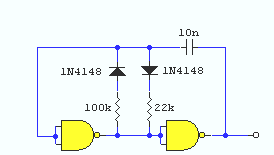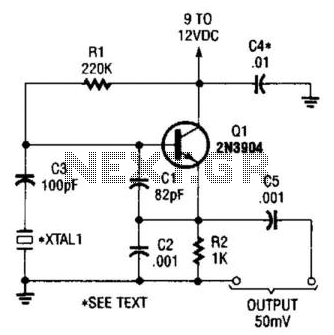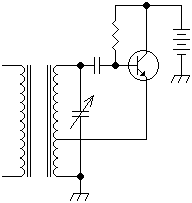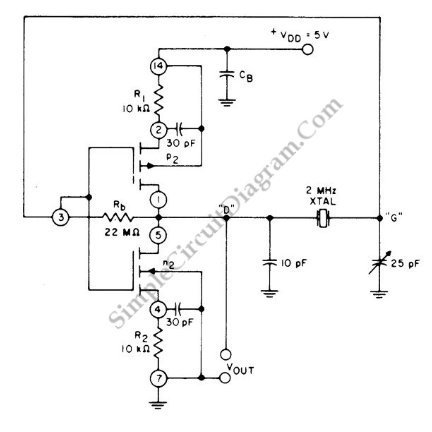
Oscillator

A tone generator operates on as little as 1.5 VDC using the Sallen-Key configuration. The tone generator will be applied to implement a phantom-powered signal source for testing balanced microphone inputs. Textbooks and web pages typically depict the Wien Bridge configuration when discussing single-opamp audio oscillators. The Wien Bridge circuit will oscillate at a frequency equal to 1/(2 Oscillation will be self-starting when the overall gain exceeds 3, thus requiring (R3/R4 + 1) > 3, or R3/R4 > 2. Once oscillation begins, additional circuit elements must be utilized to maintain a constant output level with low harmonic distortion. Tuning this type of oscillator is complicated by the fact that the gain required for stable oscillation depends on the matching of tuning resistors and capacitors. Therefore, the output level of an RC (resistance-capacitance) oscillator can fluctuate significantly when adjusting the frequency. For a tunable single-opamp RC oscillator, care must be taken to ensure that the resistors and capacitors remain equal as they are varied. This design introduces a new circuit for RC oscillators based on the Sallen-Key equal-component-value second-order low-pass (LP) filter, which functions as an LP filter with the input grounded. Being a second-order circuit, it possesses built-in capacity for sustained oscillation, a feature that designers typically avoid. The frequency is identical to that of the Wien Bridge oscillator, calculated as 1/(2 RC) where R = R1 = R2, and C = C1 = C2. The oscillation condition mirrors that of the Wien Bridge configuration, requiring an overall gain greater than 3. Most operating parameters of this new circuit are similar to those of the Wien Bridge oscillator. A circuit must be added to start with a gain slightly greater than 3 and then maintain a gain of exactly 3 once the sine wave output reaches the desired level. The Sallen-Key architecture, being an LP filter, is expected to naturally suppress distortion in the form of harmonics, which are defined as frequencies above the fundamental. Both the LP filter and the oscillator are tuned using the same two resistors and two capacitors, ensuring that any change in oscillation frequency simultaneously tunes the LP filter. Near the oscillation frequency, both band-pass (BP) and low-pass (LP) filters exhibit high quality factor (Q) and steep skirts. However, their responses differ significantly far from the oscillation frequency. The BP filter ultimately decreases at 6 dB/octave, while the LP filter decreases at 12 dB/octave on the high side, potentially offering superior suppression of higher harmonics. The design aims to create a tone generator capable of operating on just two 'N' cells in series, totaling +3.0 VDC, but it must function down to +1.5 VDC as the batteries approach end-of-life. The design utilizes Bob Widlar's LM10 op-amp and voltage reference, available in an 8-pin DIP package from National Semiconductor. This integrated circuit (IC) features a rail-to-rail main output, a common mode input range that includes ground, and can be connected to single-polarity power supplies ranging from +1.2 VDC to +40 VDC. The chosen output level for this circuit is -10 dBu, equivalent to 245 mVac, a standard level used in home hi-fi and amateur recording equipment, allowing for direct connection to any RCA input jack. The output swing for this level is 0.7 Vpp, which is achievable for the LM10, even when powered at the minimum supply voltage.
The tone generator circuit, designed around the Sallen-Key configuration, operates efficiently at low voltages, making it suitable for portable applications. The Sallen-Key low-pass filter configuration provides a unique advantage in maintaining oscillation stability, as it inherently supports sustained oscillation without the need for additional components typically required in Wien Bridge circuits. This design allows for a straightforward implementation of a tone generator that can be easily adjusted for frequency tuning while minimizing harmonic distortion through its filtering characteristics.
In practical applications, the circuit can be implemented using standard components, ensuring accessibility for hobbyists and professionals alike. The use of the LM10 op-amp is particularly advantageous due to its wide supply voltage range and rail-to-rail output capability, making it versatile for various audio applications. The design's ability to maintain a constant gain and output level is critical for testing balanced microphone inputs, as it ensures reliable performance across different operational conditions.
Overall, this tone generator design is a robust solution for generating audio signals at low voltages, providing a valuable tool for audio engineers and technicians in both testing and practical audio applications.A tone generator that runs on as little as 1. 5 Vdc, using the Sallen-Key configuration. And finally, I`ll apply the tone generator to implement a phantom powered signal source for testing balanced microphone inputs. Textbooks and web pages usually show the Wien Bridge configuration when describing single-opamp audio oscillators.
The Wien Bridge circuit shown in sketch form below will oscillate at a frequency equal to 1/(2 Oscillation will be self-starting when overall gain is greater than 3, so we want (R3/R4 + 1) > 3, or R3/R4 > 2. Once oscillation begins, additional circuit elements must be brought into play to maintain a constant output level with low harmonic distortion.
Tuning this kind of oscillator is complicated by the fact that the amount of gain required to maintain stable oscillation depends on how closely the tuning resistors and capacitors are matched. This is why the output level of an RC (resistance-capacitance) oscillator bounces around so much when setting the frequency.
If you need a tunable single-opamp RC oscillator, then you need to take special care to be sure that R`s and C`s remain equal as they are varied. Here I`ll diverge from standard practice and introduce a new circuit for RC oscillators. Based on the Sallen-Key equal-component-value second-order LP (low-pass) filter, my new circuit is nothing more than an LP filter with the input grounded.
Because it is second-order, this circuit has the capacity for sustained oscillation built in, which designers normally try to avoid. Frequency is the same as for the Wien Bridge oscillator, which is 1/(2 RC) where R = R1 = R2, and C = C1 = C2.
The condition for oscillation is also the same as for the Wien Bridge configuration, which is an overall gain greater than 3. Actually, most operating parameters of this new circuit are similar to the Wien Bridge oscillator. We`ll need to add a circuit which starts up with gain slightly greater than 3, and then maintains gain at exactly 3 once the sine wave output reaches the desired level.
My idea in thinking of the Sallen-Key architecture was that since it is already an LP filter, it should naturally suppress distortion in the form of harmonics, which are by definition above the fundamental. The LP filter and the oscillator are each tuned by the same two resistors and two capacitors, so that whenever you change the oscillation frequency, you have already tuned the LP filter at the same time.
Near the oscillation frequency, both BP (band-pass) and LP filters exhibit high `Q` and steep skirts. Far from the oscillation frequency however, their responses are quite different. The BP filter ultimately falls off at 6 dB/8va while the LP filter falls off at 12 dB/8va on the high side, potentially offering much better suppression of higher harmonics.
If I get a chance to study this effect in detail I`ll report my results here. I had in mind to design a tone generator which could operate on just two `N` cells in series, a total of +3. 0 Vdc. But running to end-of-life for the batteries would mean operating on as little as +1. 5 Vdc. So I started with Bob Widlar`s LM10 opamp and voltage reference which comes in an 8-pin DIP package from National Semiconductor and is available from distributors like Digikey.
This IC (integrated circuit) features a rail-to-rail main output, a common mode input range that includes ground, and it can be connected to single-polarity power supplies ranging from +1. 2 Vdc up to +40 Vdc. I chose an output level of -10 dBu for this circuit, or 245 mVac. This is a standard level used in home hi-fi and amateur recording equipment, and can be connected directly to any RCA input jack.
Output swing for this level is 0. 7 Vpp, which is well within reach for the LM10, even when powered at the minimum supply volt 🔗 External reference
The tone generator circuit, designed around the Sallen-Key configuration, operates efficiently at low voltages, making it suitable for portable applications. The Sallen-Key low-pass filter configuration provides a unique advantage in maintaining oscillation stability, as it inherently supports sustained oscillation without the need for additional components typically required in Wien Bridge circuits. This design allows for a straightforward implementation of a tone generator that can be easily adjusted for frequency tuning while minimizing harmonic distortion through its filtering characteristics.
In practical applications, the circuit can be implemented using standard components, ensuring accessibility for hobbyists and professionals alike. The use of the LM10 op-amp is particularly advantageous due to its wide supply voltage range and rail-to-rail output capability, making it versatile for various audio applications. The design's ability to maintain a constant gain and output level is critical for testing balanced microphone inputs, as it ensures reliable performance across different operational conditions.
Overall, this tone generator design is a robust solution for generating audio signals at low voltages, providing a valuable tool for audio engineers and technicians in both testing and practical audio applications.A tone generator that runs on as little as 1. 5 Vdc, using the Sallen-Key configuration. And finally, I`ll apply the tone generator to implement a phantom powered signal source for testing balanced microphone inputs. Textbooks and web pages usually show the Wien Bridge configuration when describing single-opamp audio oscillators.
The Wien Bridge circuit shown in sketch form below will oscillate at a frequency equal to 1/(2 Oscillation will be self-starting when overall gain is greater than 3, so we want (R3/R4 + 1) > 3, or R3/R4 > 2. Once oscillation begins, additional circuit elements must be brought into play to maintain a constant output level with low harmonic distortion.
Tuning this kind of oscillator is complicated by the fact that the amount of gain required to maintain stable oscillation depends on how closely the tuning resistors and capacitors are matched. This is why the output level of an RC (resistance-capacitance) oscillator bounces around so much when setting the frequency.
If you need a tunable single-opamp RC oscillator, then you need to take special care to be sure that R`s and C`s remain equal as they are varied. Here I`ll diverge from standard practice and introduce a new circuit for RC oscillators. Based on the Sallen-Key equal-component-value second-order LP (low-pass) filter, my new circuit is nothing more than an LP filter with the input grounded.
Because it is second-order, this circuit has the capacity for sustained oscillation built in, which designers normally try to avoid. Frequency is the same as for the Wien Bridge oscillator, which is 1/(2 RC) where R = R1 = R2, and C = C1 = C2.
The condition for oscillation is also the same as for the Wien Bridge configuration, which is an overall gain greater than 3. Actually, most operating parameters of this new circuit are similar to the Wien Bridge oscillator. We`ll need to add a circuit which starts up with gain slightly greater than 3, and then maintains gain at exactly 3 once the sine wave output reaches the desired level.
My idea in thinking of the Sallen-Key architecture was that since it is already an LP filter, it should naturally suppress distortion in the form of harmonics, which are by definition above the fundamental. The LP filter and the oscillator are each tuned by the same two resistors and two capacitors, so that whenever you change the oscillation frequency, you have already tuned the LP filter at the same time.
Near the oscillation frequency, both BP (band-pass) and LP filters exhibit high `Q` and steep skirts. Far from the oscillation frequency however, their responses are quite different. The BP filter ultimately falls off at 6 dB/8va while the LP filter falls off at 12 dB/8va on the high side, potentially offering much better suppression of higher harmonics.
If I get a chance to study this effect in detail I`ll report my results here. I had in mind to design a tone generator which could operate on just two `N` cells in series, a total of +3. 0 Vdc. But running to end-of-life for the batteries would mean operating on as little as +1. 5 Vdc. So I started with Bob Widlar`s LM10 opamp and voltage reference which comes in an 8-pin DIP package from National Semiconductor and is available from distributors like Digikey.
This IC (integrated circuit) features a rail-to-rail main output, a common mode input range that includes ground, and it can be connected to single-polarity power supplies ranging from +1. 2 Vdc up to +40 Vdc. I chose an output level of -10 dBu for this circuit, or 245 mVac. This is a standard level used in home hi-fi and amateur recording equipment, and can be connected directly to any RCA input jack.
Output swing for this level is 0. 7 Vpp, which is well within reach for the LM10, even when powered at the minimum supply volt 🔗 External reference
Warning: include(partials/cookie-banner.php): Failed to open stream: Permission denied in /var/www/html/nextgr/view-circuit.php on line 713
Warning: include(): Failed opening 'partials/cookie-banner.php' for inclusion (include_path='.:/usr/share/php') in /var/www/html/nextgr/view-circuit.php on line 713





